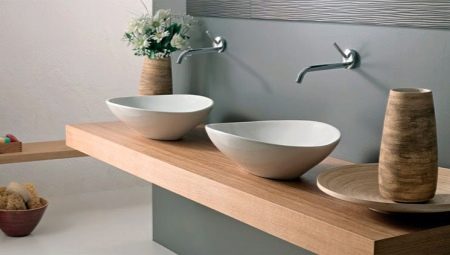Today, the so-called false sinks for the bathroom come to replace the classic washbasins. They are more practical in terms of ease of use, space occupied, as well as ease of installation. In this article, you will learn about the features of using and choosing overhead sinks for bathrooms.





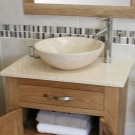
Advantages and disadvantages
Overhead sinks today are rapidly gaining popularity in the design of bathrooms - this can be explained by a number of advantages that such designs possess.
- Space saving. To install the overhead sink does not require a separate place or corner in the bathroom - it is installed directly on the countertop, which can be an ordinary cabinet with plumbing or detergents.
- Easy installation. Any sink needs competent installation and wiring of communications, but thanks to its design, overhead models can be installed independently at home.
- Universality. Overhead sinks can be installed almost anywhere in the bathroom, the only condition in this case is the presence of a horizontal surface. False sinks are usually installed in hard-to-reach places like corners or narrow niches.
- Tightness. Fortunately, sealing a false sink is very simple - the joints between the countertop and the bowl can simply be filled with sealant, and the sink will be ready for long use.
- Practicality. The countertop, on which the false sink will be installed, can perform not only the function of the base - it will also be an excellent platform for detergents and other bath accessories.
- Design. In the case of overhead washbasin models, you have a huge choice among the possible design options and design of such structures. The ability to install anywhere led to the creation of completely non-standard shapes and sizes from a wide variety of materials. Such a sink can not only become practical furniture, but also effectively complement the interior of the room and even become its compositional center.



As such, there are no shortcomings in overhead sinks. Separate negative features relate to strictly defined models and can occur with improper installation of the model.
As an example, some overhead sinks may not have a hole for the mixer.

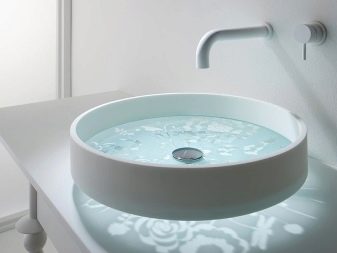
Materials
Today, overhead sinks on bathroom countertops can be performed from virtually any material with high strength. On the shelves of plumbing stores you can find models from metal, ceramics, natural stone, wood and even glass. However, the most popular raw material for the manufacture of surface models of sinks in the bathroom remains sanitary porcelain and sanitary ware.
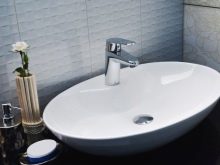
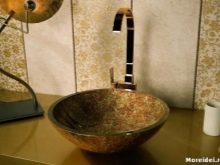
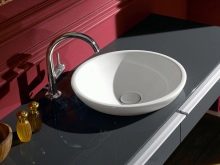
Consider the features of using each of the listed materials.
- Glass. Glass sink - an original and interesting from a design point of view, a choice that can look good in many style decisions. Shells can be made of glass in the most bizarre shapes and designs, which puts them much higher than sinks made of other materials. The minus of the glass is obvious - every drop of water is perfectly visible on it, which dries out over time and leaves ugly white stains.
Another minus of glass in its relatively low strength is that it is strictly forbidden to drop heavy objects or put metal bath accessories on such models of sinks.
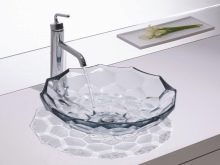
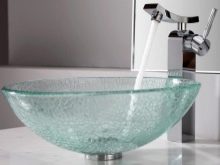
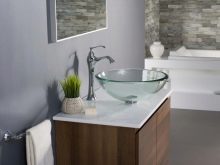
- Natural or artificial stone. Here most often there are products made from natural porcelain, marble, granite, models from stone chips or unusual minerals. Such sinks look extremely unusual in the design of the bathroom due to its texture and original color, but as a minus they have a lot of weight, which forces the installation of countertops with a more rigid mount.
In addition, cracks or scratches may appear on the stone over time; There are cases when stone sinks simply collapsed over time from the regular use of very hot water.
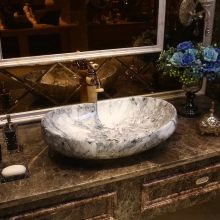
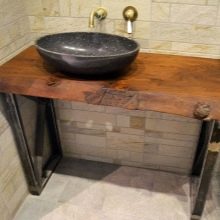
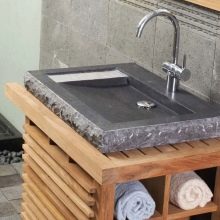
- Wood. Natural bamboo, oak or teak are commonly used to create wood sinks. Such models are rare in the design of standard apartments - all because of the low resistance of wooden components to moisture and a constant high level of humidity. This is not a very practical (albeit original) choice for the bathroom, as these models will require careful care and treatment with special oils to prevent moisture from entering the pores of the wood.
The same applies to the care of such a sink with aggressive detergents with abrasive substances or acids and alkalis in the composition.

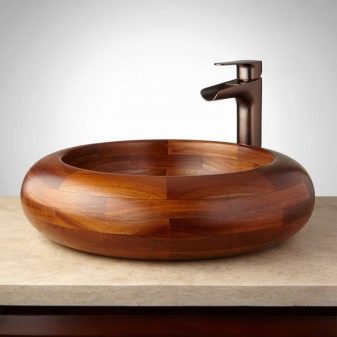
- Ceramics is the most popular and budget material in the creation of sinks for kitchens and bathrooms. This material is incredibly easy to care for, has a relatively low weight and can be made in a variety of designs and colors. In addition, ceramics rarely have any stains or scratches - this is an incredibly stable and clean material.
Unlike other materials, ceramics do not need any specific care.
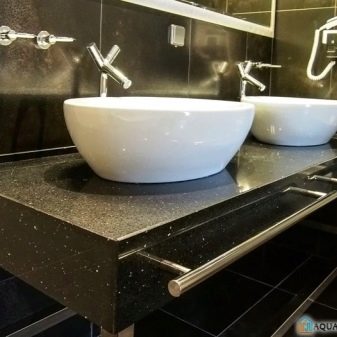
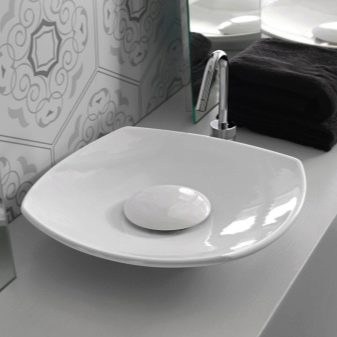
- Metal. If we talk about metal overhead models of sinks for bathrooms, then they are most often made of brass, stainless steel or copper.To give these models greater appeal, they are usually coated with a layer of acrylic on the outside. Plus metal products at a relatively low cost and long service life.
If it comes to cons, then metal furniture should always be strictly maintained using special cleaning products.
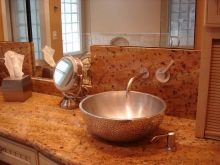
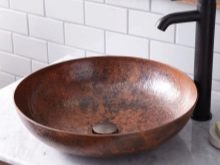
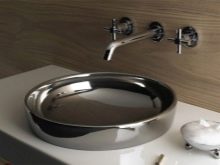
- Acrylic. Usually, fonts for bathrooms are made of acrylic, but this material has become a good alternative for washbasins. Acrylic is quite durable, lightweight, tolerates temperature extremes, looks nice and does not need special care. In addition, acrylic models are not very expensive and can be custom made in absolutely any shape or size.
The only thing that should not be allowed is mechanical damage and shock to acrylic.


- Faience and porcelain sinks considered one of the most popular, expensive and environmentally friendly. They are resistant to scratches and tolerate extreme temperature changes. Due to the smooth and opaque coating, models made of such materials are very easy to care for.
If we talk about significant shortcomings, then here they are obvious - a little resistance against mechanical damage and high loads.
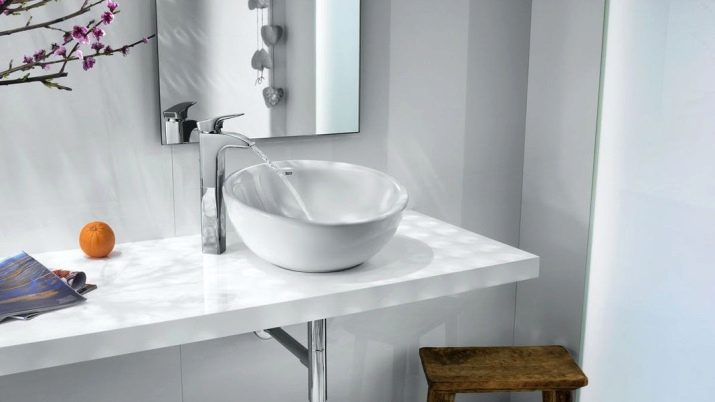
Shapes and sizes
There is a whole classification that is responsible for the variety of shapes of overhead sinks for bathrooms. It includes round (bowl-shaped), oval, triangular, rectangular shell models, as well as models of non-standard and asymmetric shapes. When choosing an overhead sink of a certain shape, you should focus on an existing design in the room.
For example, in the style of minimalism, which prefers practicality, simplicity and conciseness, it will be inappropriate to use non-standard forms of sinks from the same natural stone.

- Round bowls or bowls. Today, this variety is justifiably considered classic. Small round sinks are suitable only for washing hands, while large ones can be used for washing your hair, dishes, or even become a full font for a child. Another plus of round sinks is the fact that they can be approached from any direction.
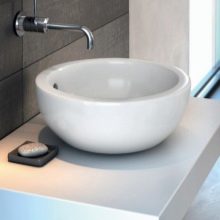

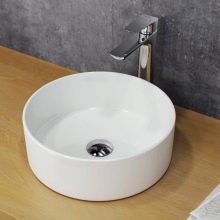
- Models are oval. This is the most popular form for overhead sinks. The oval is considered a universal choice and is ideally suited both for washing your hair and for regular hand washing.
The minus of oval sinks is that they look good only in large and spacious bathrooms, and also that their elongated shape requires an elongated tabletop.
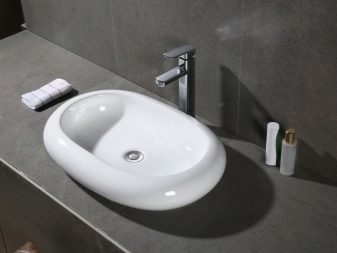
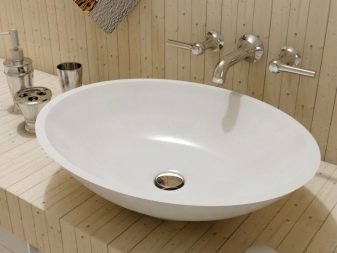
- Square or rectangular shapes. These are also quite common options that can be found in abundance on store shelves. The advantage of models with right angles is that they can fit perfectly into absolutely any interior and can be installed in a room of any size. For bathrooms with limited free space, you should choose models of rectangular sinks with rounded corners. This form of sinks is considered extremely convenient in terms of practicality - in a rectangular sink, thanks to the flat surface of the bottom near the drain, it is convenient to wash the dishes.
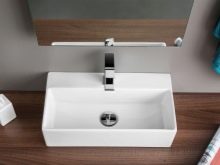
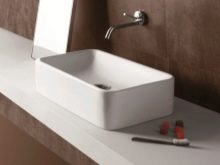
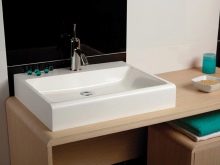
- Triangular or angular patterns. The plus of the triangular shape is that such models can be installed in the corners of the bathroom. This allows you to maximize the use of all free space in the room and maintain a sense of spaciousness.
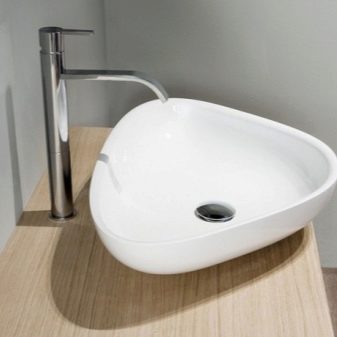

- Models of sinks of complex and unusual shapes. As a rule, here we mean creative author's models of sinks in the most unusual design. It can be sinks with two faucets (or plums), models made in the form of flower petals, fonts with holes cut directly in natural stone.
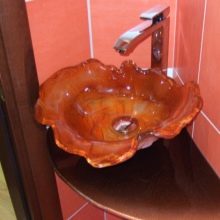
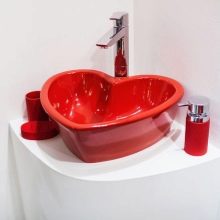

If we talk about the choice of sizes of surface sinks for the bathroom, then you need to rely not only on the dimensions of the room itself, but also on the purpose of such structures. For example, in small and compact washbasins you can only wash your hands or use them for brushing your teeth, more voluminous and dimensional constructions are suitable as a font for washing a child, washing his hair or kitchen utensils.

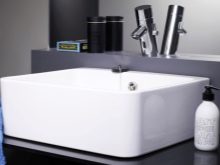

When choosing the dimensions of the sink Pay attention to the material of your countertop. For materials that are susceptible to the harmful effects of moisture (wood or MDF), oversized sinks with a large depth should be selected. Such dimensions will not allow excess moisture to fall on the countertop (for example, when you wash your hands or shake them from water).
Fortunately, there are no strict standards that require the installation of overhead sinks of certain dimensions.
The choice of size in this case lies precisely on your shoulders - you must choose it, taking into account the area of the room, its style and the material of the countertop.
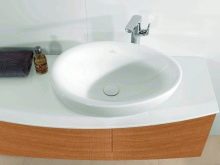

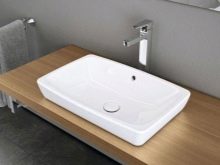
All overhead sinks can be conditionally divided into 3 groups depending on their size:
- miniature or compact models - all sinks with dimensions not exceeding 40x40 cm;
- medium sized models - designs with dimensions of length and width not more than 70x60 cm, and also depth not more than 20 cm;
- overall and volume sinks - all models with dimensions of more than 120 by 60 cm and a depth of up to 30 cm.
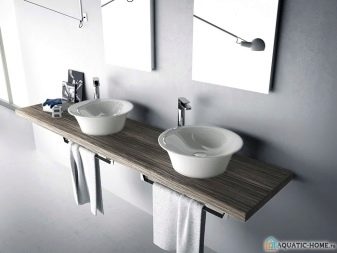
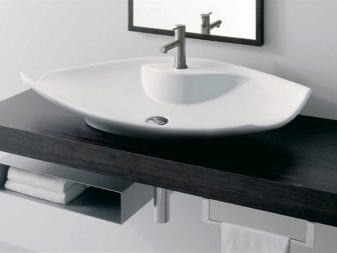
At what height should I hang?
An important factor when installing the washbasin in the bathroom is the height of its installation. Typically, this indicator is selected based on the installation height of the countertop itself, however, it can be adjusted using various airtight supports (to increase the height) or by mounting the sink in a cut at a lower height.

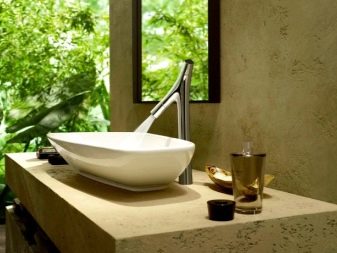
Standard bathroom cabinets are usually installed at a height of no higher than 80 cm - This is the optimal height, taking into account average human height. For people with higher growth, overhead sinks with thicker edges and a total height together with a worktop of 85 cm or more can be selected.
Fortunately, in the case of height, there are no strict dogmas here - You can choose the height of the sink yourself, for example, taking into account the growth of your children.
However, it should be ensured that the selected height is sufficient for laying communications and pipes for supplying and withdrawing water.
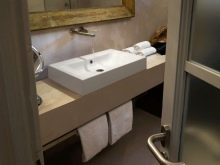
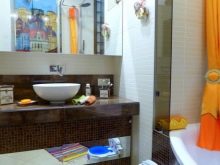
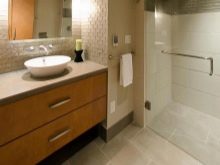
Design
Today, overhead sinks for bathrooms can be made in a variety of and fancy design options. Some models of sinks will look good only in a certain style, while others (for example, standard oval or rectangular white sinks) are universal and fit perfectly into any design.
- Classic. For a bathroom made in a classic style, oval or rectangular models of false sinks in white, wheat or cream color are best suited. The main requirement for such sinks is a rich appearance, which can be achieved through the use of gilded faucets or sinks.
Particular attention should be paid to the choice of countertops for this style - this is most often the curbstone on the curved gilded legs of natural wood or MDF.

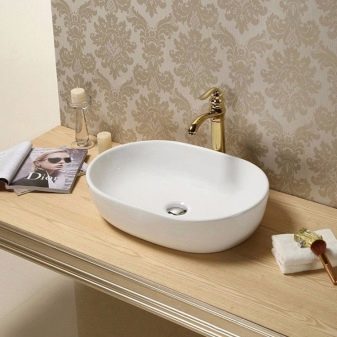
- Minimalism. Minimalist style bathrooms do not accept extra grace. These should be purely practical models of white or dark shells, usually oval or square. If we talk about the material for making the sink, then absolutely all elements with a calm and uniform texture will be appropriate to look here - without patterns, fancy shapes and contrasting colors.
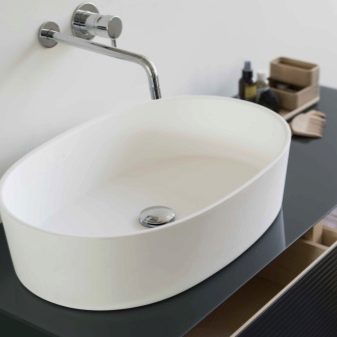

- Modern. Unlike the styles described above, Art Nouveau does not impose any serious requirements on the shape or color of false sinks or countertops. Here, sinks of absolutely all shapes, sizes and colors (usually light) can be successfully used.
The only condition is the harmony of the washbasin with the color scheme of the bathroom. Of the materials here, porcelain, earthenware, or acrylic are commonly used.
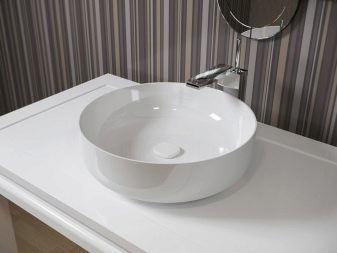

- Country. Bathrooms made in this style simply adore pastel and warm colors. Both porcelain, wooden, acrylic, and stone models of washbasins will look great here. The main emphasis here is precisely on the choice of countertops - it should be in harmony with the background of the room, but create a pleasant contrast between the color of the sink.
If we talk about the preferred forms, then in the country style, both oval, square, and triangular shells look great.

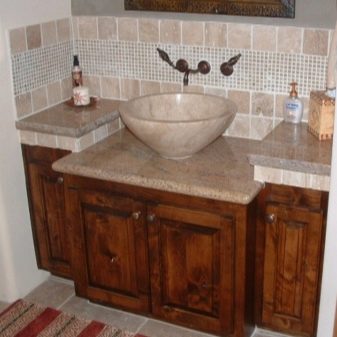
- Art Deco. This is perhaps the richest and most demanding style among the rest. In such bathrooms only expensive versions of oval or square porcelain or earthenware sinks will look successful. The color here is usually chosen white, cream or dark.
The art deco washbasin should have a nice glossy finish and have an elegant gold or silver faucet.


Manufacturers Overview
Today in stores you can find just a huge number of overhead models of sinks of various brands, but not all of them deserve attention. Below is a list of manufacturers that produce the best models of overhead washbasins.
- Among Russian manufacturers, one can distinguish a brand Melana which produces very high-quality, albeit fairly budget-friendly products from sanitary faience. This company has been operating in the Russian market for over 13 years and produces models no worse than European ones.
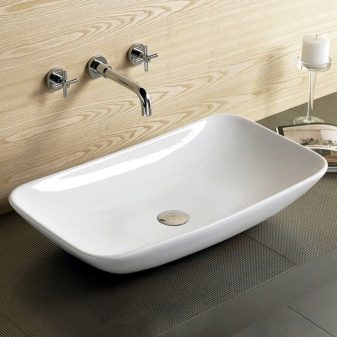
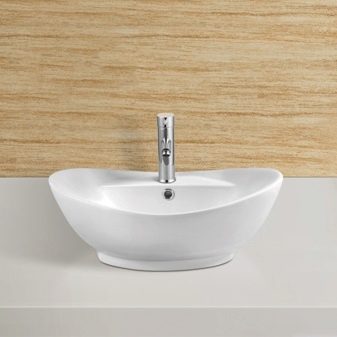
- Villeroy & boch is an international company that produces classic overhead washbasins. Prices for the goods of this company can seriously hit the wallets of ordinary Russian consumers, but this technique, made of high-quality ceramic and sanitary porcelain, is worth the money.
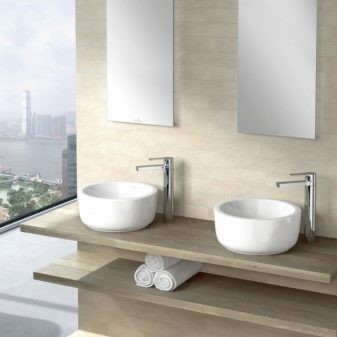
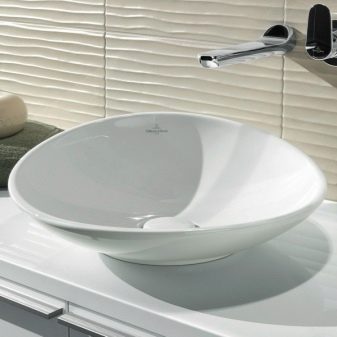
- Roca - One of the most popular Spanish companies for the manufacture of building materials. As a rule, this brand produces high-quality, beautiful and durable ceramic washbasins.
The main advantage of the brand can be considered a variety of models of the most bizarre and original forms.
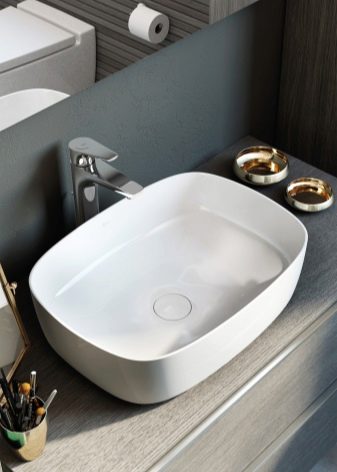
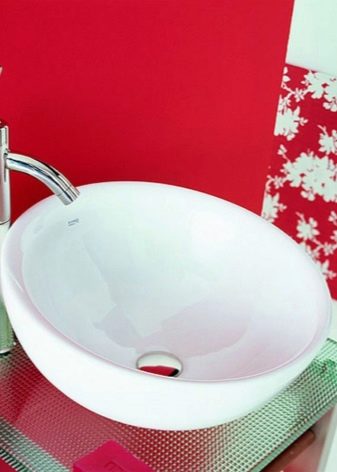
- If we talk about French brands, then you can not ignore the manufacturer Jacob delafon - He has been manufacturing sanitary ware for over a century. This company specializes in the production of sinks of classical shapes and sizes, and also offers an impressive selection of washbasins of non-standard shapes made of glass and natural stone.
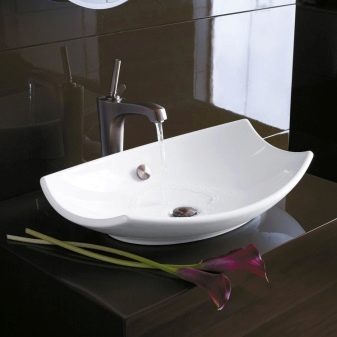
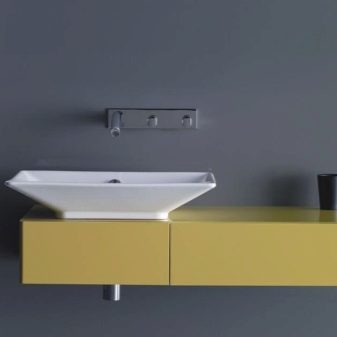
- Turkish brand Vitra offers durable, safe and low-cost models of overhead sinks for bathrooms. In addition to the described, almost every product element is offered a long-term warranty for up to 25 years.
Of the additional advantages, one can also distinguish a good, although small, choice of countertops for sinks.
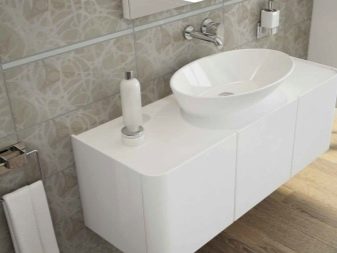
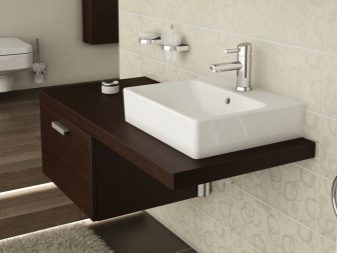
- Polish company Cersanit has been manufacturing world-class sanitary ware for over 20 years. The products of this brand are made of durable and high-quality materials, but at an affordable price.
In addition, the company offers a large selection of a wide variety of countertops for washbasins.

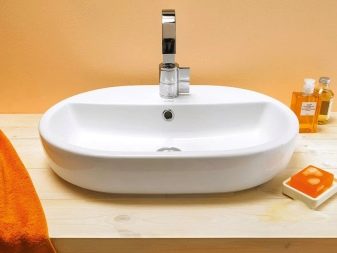
Of the less well-known brands that also produce decent plumbing, we can distinguish two Chinese manufacturers (Salsa Basin, Salsa Basin), the German brand Duravit, as well as the Swiss company Laufen.
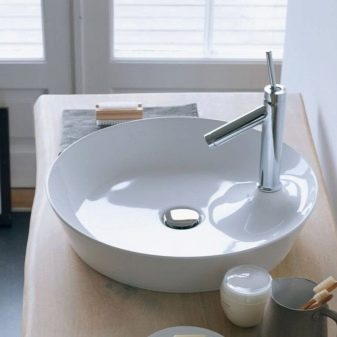

How to choose?
When choosing overhead sinks for bathrooms in the same way as when buying absolutely all elements of furniture, you need to follow certain recommendations. The factors described below will help you choose the perfect model for your bathroom.
- Dimensions of the room and countertops. This is the main factor when choosing overhead sinks. Before buying, be sure to evaluate the dimensions of your room, measure the width and length of the existing countertops, and try to imagine which of the forms of sinks will look best in your bathroom. Already with this information, go to the store and choose the right model for yourself.
If you are not sure about the appropriateness of a particular model in your room, it is worthwhile to create an approximate floor plan taking into account such a design.
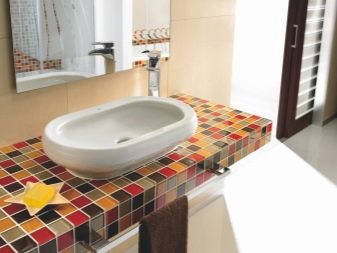

- Integrity and appearance. Since most bathroom overhead structures are made of fragile materials that do not tolerate mechanical damage and scratches, carefully examine the proposed models when purchasing. They should be free of chips, cracks, scratches and dents (if we are talking about metal models). By the appearance of the sink, you can determine whether it has been used before, and also evaluate the thickness of the outer coating (if any).
A special inspection should be subjected to models of false sinks made of porcelain, ceramics and glass.


- Forms. If your house has small children or elderly people, it is better to choose models of sinks with rounded corners. This will prevent serious injury. If you choose a sink that will also serve for bathing a child, it is better to stop on oval-shaped models and materials that are not too hard and quickly heat up.
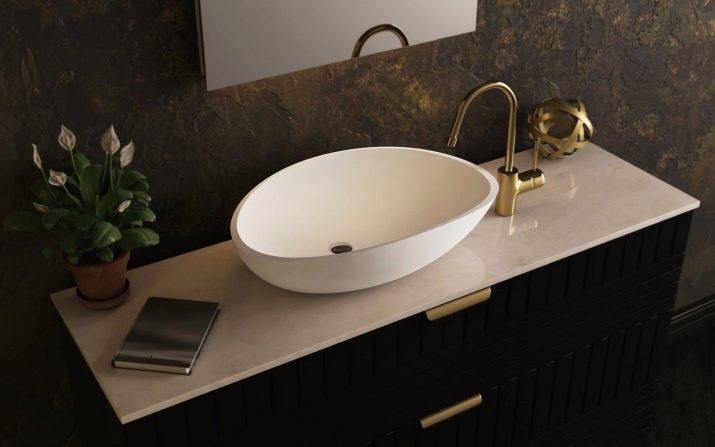
- Accessories When choosing a washbasin sink, focus not only on the unit itself, but also on the sizes of related accessories. For example, if you bought a deep model of a laid-on sink, low taps here will not fit either in terms of practicality or in appearance. If you are more inclined towards practicality when choosing a wall-mounted design than towards appearance, you can buy sink models with two taps, offset drain or special openings for bath accessories.
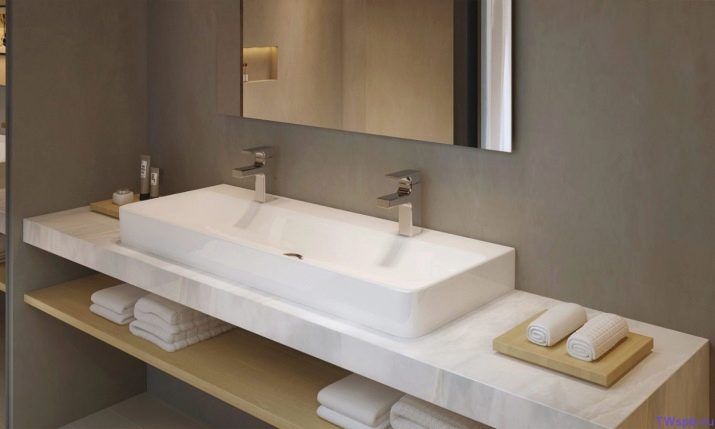
- Style. When choosing a specific model of the overhead sink, it’s not enough to dwell on some beautiful washbasin. It should be in harmony with the chosen style decision of the room, as well as with its color background.

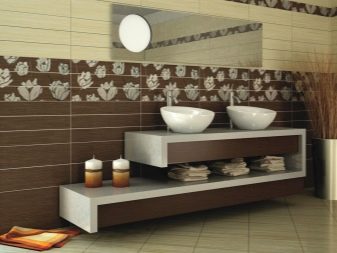
It will also be worthwhile to pay attention the choice of the countertop itself for the installation of a washbasin. The standard option in this case are models made of wood, plastic or MDF.
In any case, it should be environmentally friendly, durable (to withstand the weight of the sink), as well as material resistant to moisture and household chemicals. In addition, it should also be in harmony in texture and color with the design of the bathroom.


Examples in interior design
Below you will find beautiful and stylish examples of overhead sinks in a different design and style solution for the bathroom.
- Classic. Pay attention to the pleasant white, cream tones of the washbasins, as well as the gilding and silver faucets.

- Minimalism. Bright signs of this style are practicality and simplicity, neutral colors and classic shapes.
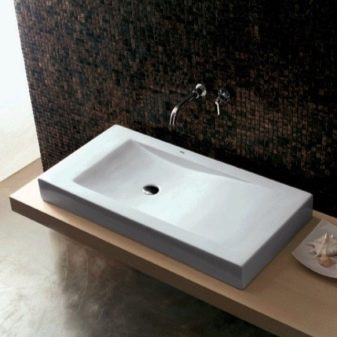

- Country. This style loves warm and pastel shades, in addition, in such a design, stone and wooden textures of the countertop or the washbasin itself are often found.
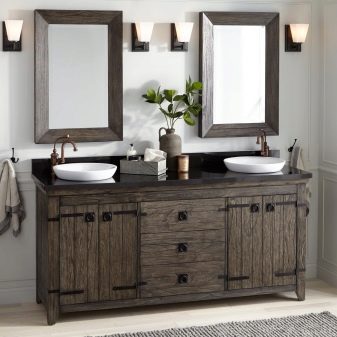
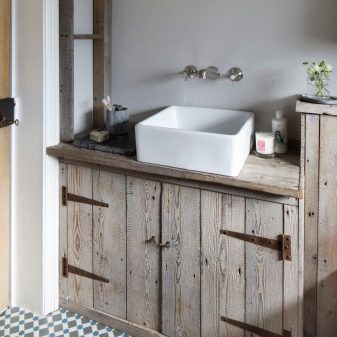
- Creative. Pay attention to the variety of shapes, materials, sizes and colors in which overhead sinks can be made.
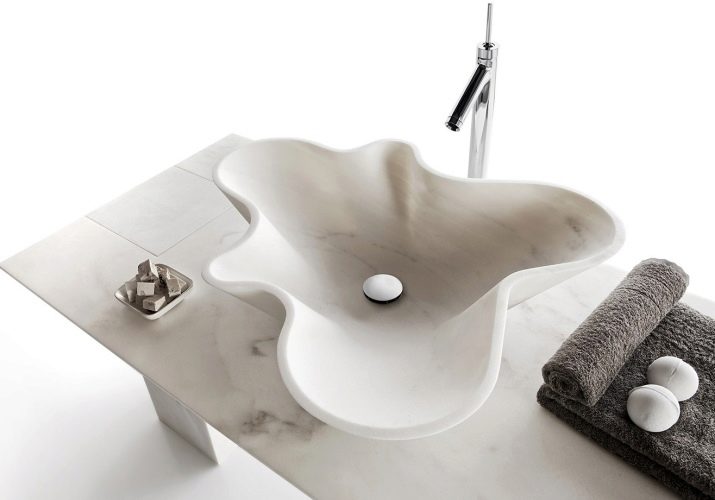

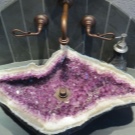

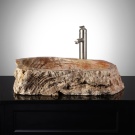
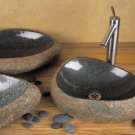
See how to choose a sink in the next video.
